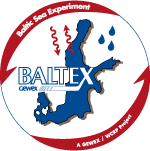| Research objectives > The water and energy cycle in the Baltic Sea basin

The main field of BALTEX research has been the water and energy cycle of the Baltic Sea basin. Scientists have improved the observation network of field stations measuring rain, snow and ice all over the basin, as well as energy in the form of heat and radiation, driving the water cycle. A central research goal has been the development of computer models which are able to simulate the water and energy cycle. This is not only important for the understanding of the processes, but also helps to find out what happens to the water and energy cycle in a warmer climate.
In order to arrive at reliable climate scenarios for the Baltic Sea region, we need to understand as many details of the water and energy cycle as possible. With the help of regional hydrological models (i.e. mathematical models which can simulate the water cycle) and more and better observation methods to measure the amount of rain, snow, evaporation, fog, water vapour and clouds, but also heat transfer, BALTEX scientists strive for a better understanding of the water and energy cycle. Questions to be answered are for example:
- how much water evaporates over the Baltic Sea and over land, in summer or winter (there are large differences between different landscapes like mounain areas, forests, or agricultural land);
- how much precipitation falls over the Baltic Sea, and over land in summer or winter;
- how much snow (and where) falls in winter;
- where does the water go to (i.e. how much evaporates back to the atmosphere; how much disappears as ground water; how much returns to the lakes and the Baltic Sea throgh rivers);
- how much heat is absorbed by the Baltic Sea and the land surface;
- how do different cloud types affect the heat and water transfer between atmosphere and sea or land surface;
- how are the sea currents affected by heat flux and freshwater inputs;
- how do the currents affect the transport of water and heat;
- how is runoff from rivers to the Baltic Sea affected by climate change.
Scientists are working at describing all of the above processes with the goal of "closing the water and energy budget". This means simply that we know how much water and energy enters and leaves each part of the system at a given time. For example, scientists still do not know how much water enters the Baltic Sea through the Danish belts and sounds, and how much is lost to the North Sea through these narrow straits. Is the budget even, i.e. is the inflow equal to the outflow? This uncertainty is due to the fact that is impossible to measure the net currents area-wide. It is only possible to make few very selective measurements, from which net fluxes must be extrapolated. Likewise, it is impossible to measure evaporation or rainfall to a high level of certainty. All these processes can only be measured representatively, and these few measurements need to be fed into computer models.
Click here for a schematic diagram of the major reservoirs and processes of the water and energy cycle of the Baltic Sea basin: the "BALTEX Box".
|

